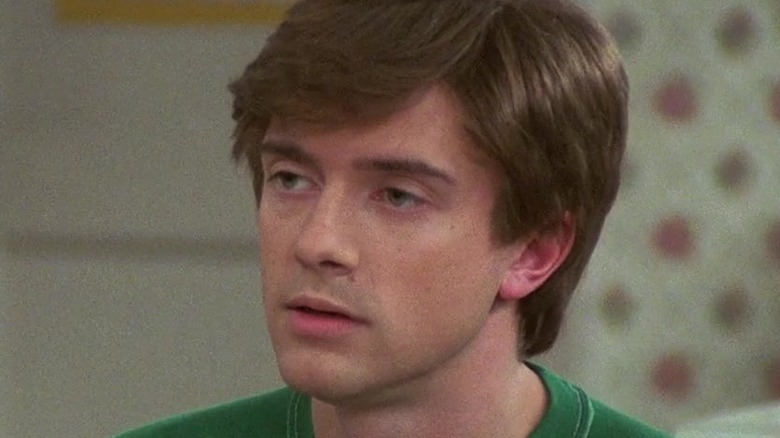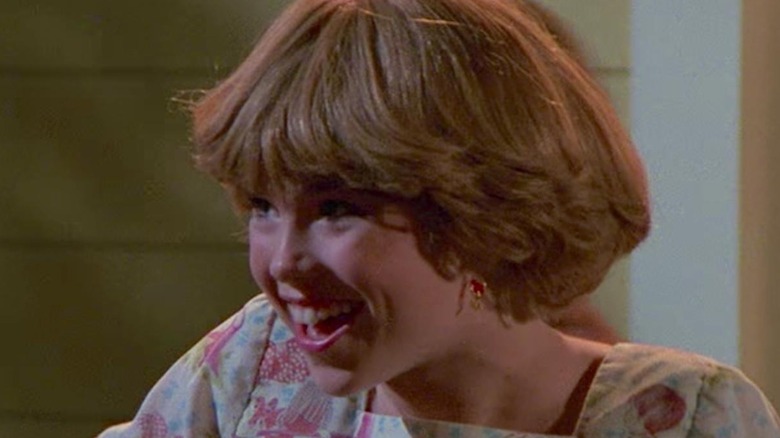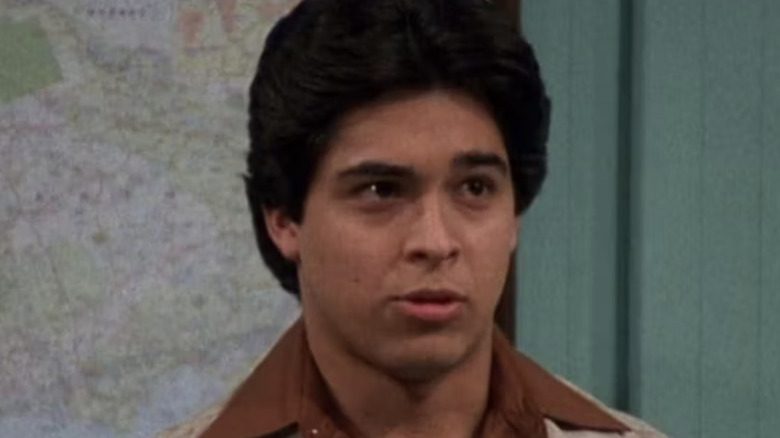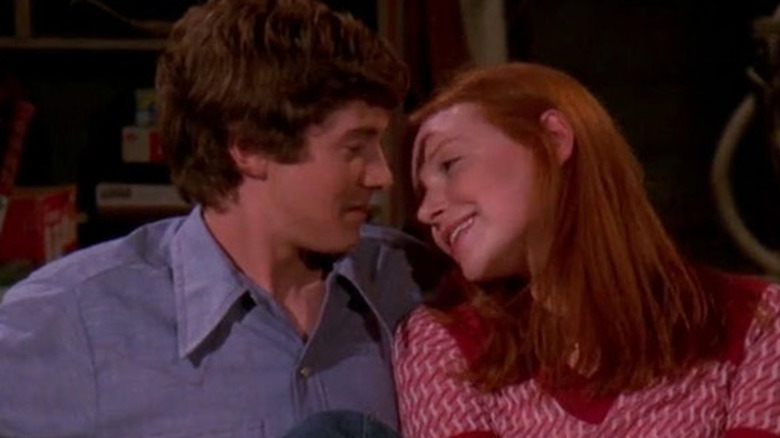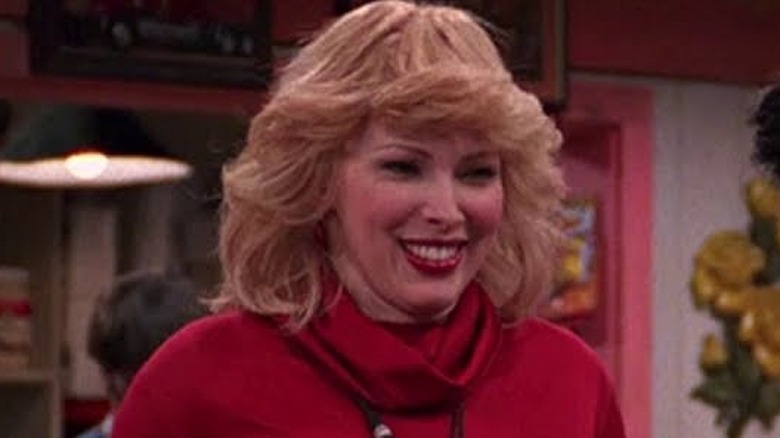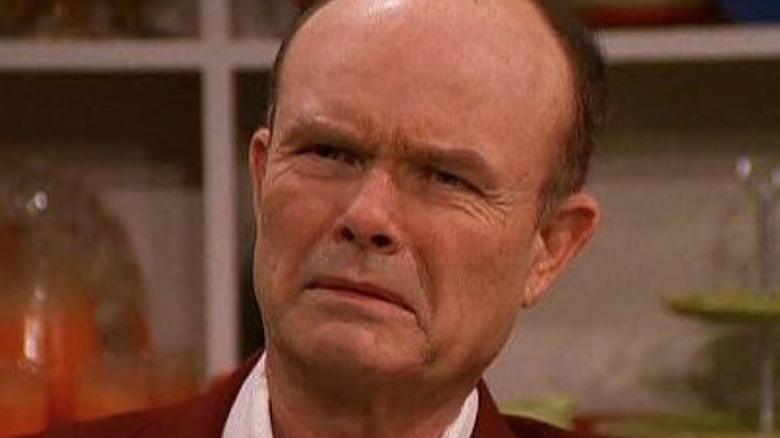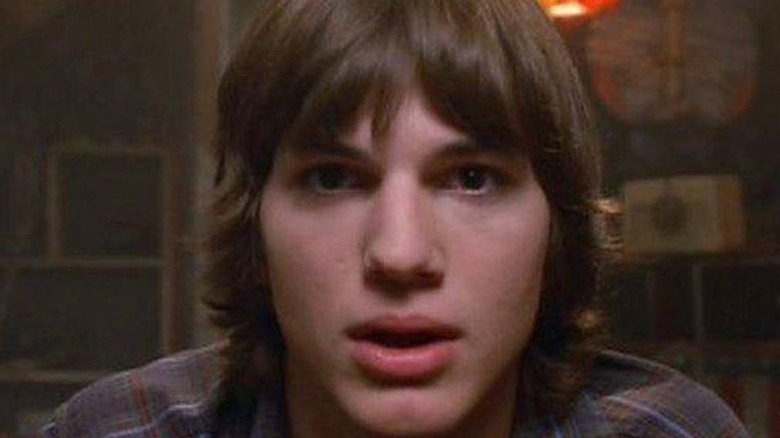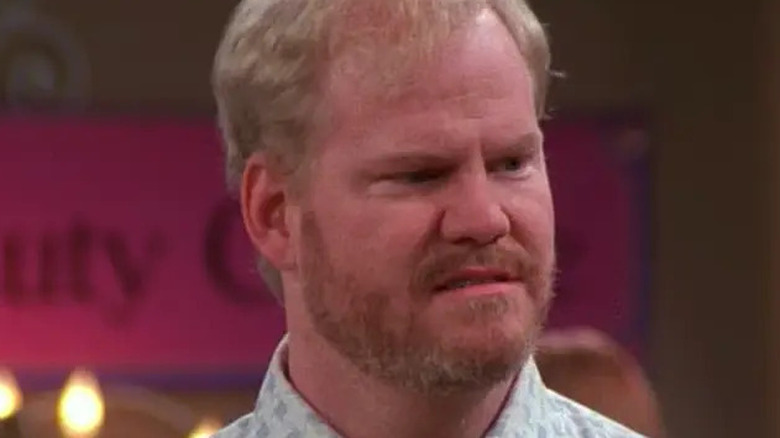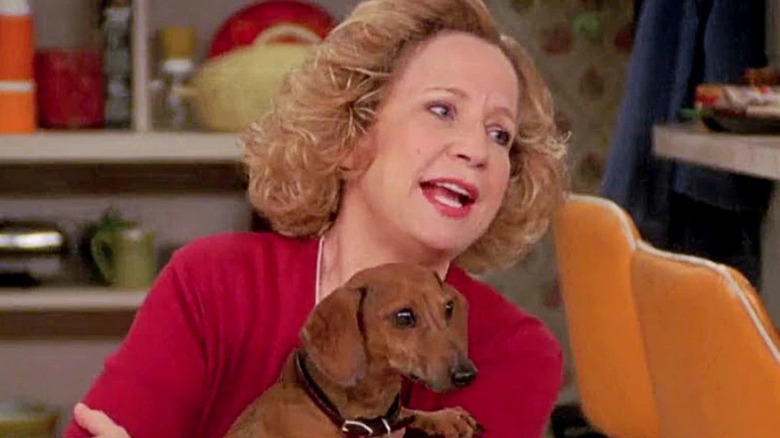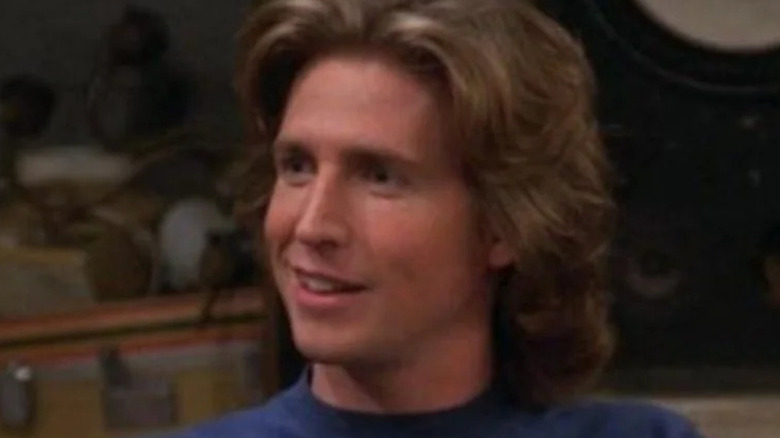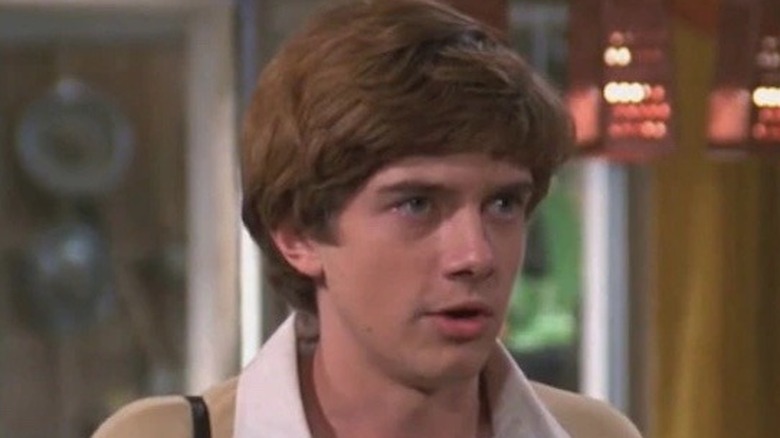Questions From That '70s Show That We Still Don't Have Answers To
"That '70s Show" ranks as one of the great friends-as-family sitcoms, one of the best teen shows, and among the last great comedies of the laugh-track-and-multi-camera era of the 1990s and early 2000s. It also made teen idols and lasting big stars out of cast members Ashton Kutcher, Topher Grace, Wilmer Valderrama, and Mila Kunis. And yet, as progressive and innovative as it was — funny interstitial segments, frank depictions of drugs and sex on network TV, breaking the fourth wall — "That '70s Show" also functioned as an unabashed and warm throwback to real sitcoms that actually aired in the 1970s.
As such, some of those shows, and thus "That '70s Show," could tend to get a little slapdash and sloppy with the way characters, plots, and other elements were introduced and then abandoned, forgotten, or contradicted. "That '70s Show" ran for eight seasons and 200 episodes, and for as many satisfying jokes and arcs as it landed, it left a lot of confusion in its wake, which may or may not be answered in the Netflix sequel series "That '90s Show." Here then are all the still-burning questions hangin' out, and down the street, from "That '70s Show."
Whatever happened to Donna's sisters?
Perhaps it's a very subtle nod to a very '70s TV trope. But it's probably just writers and showrunners figuring out the world of the show as it was already in progress and in its infancy. Regardless of the reason, Donna Pinciotti, the literal girl next door on "That '70s Show," experiences the sudden loss of two sisters — not in that they die, but that they cease to exist, and apparently never did exist either. On the fifth-ever episode of "That '70s Show," "Eric's Burger Job," Donna throws a party, and her annoying little sister, Tina, shows up to bug her sibling and flirt with Fez. Tina never shows up again, nor is she even mentioned, with plenty of dialogue references to Donna being an only child.
"That '70s Show" acted like a real '70s show in this way — in early episodes of "Happy Days," Richie and Joanie Cunningham had an older brother named Chuck, who one day walked upstairs and was never heard from again; father Howard Cunningham later referred to his "two children." "That '70s Show" came down with another mild case of "Chuck Cunningham Syndrome." In the episode "Eric's Birthday," Donna refers to her older sister Valerie, who is off at college. That's the series' only mention of Valerie Pinciotti.
What's Fez's real name and where is he from?
Frankly, it's problematic the way the Point Place gang in "That '70s Show" treats Fez. Part of their small, tight-knit social circle and ostensibly their friend, as he believes himself to be, they treat him with detached amusement, like a pet or a mascot. He's from a foreign country, dressed a bit nerdy, doesn't understand most American customs, and speaks with a thick accent — all of which make the other kids laugh at him and pick on him. His so-called friends don't even know his name. Fez isn't it — that's a wonky acronym for "Foreign Exchange Student," because that kind of international program is why he's living in Wisconsin at all.
Fez's friends never bother to use his real name, which he utters in full just once, but is comically drowned out by background noise so it's left a mystery to viewers. "That '70s Show" fans still have idea what Fez's real name is, nor do they know where he's from. That basic fact about the character is never actually revealed or even discussed long enough to provide any definitive clues.
What happened to the Eric-Donna-Hyde love triangle?
As has often been customary of sitcoms, particularly '90s sitcoms, "That '70s Show" toyed with the idea of a love triangle. It's absolutely a tantalizing plot device — it adds drama and tension to a series, fueling characters' motivations and keeping the audience both guessing and taking sides as to who belongs with whom. Early in the first season of "That '70s Show," the series established that Donna and Eric were likely going to get together — after all, they lived next door to one another, flirted constantly, and enjoyed a nice rapport.
But then, as if to make things interesting, or perhaps to motivate Eric to tell Donna how he really felt about her, the writers introduced the idea that Hyde, Eric's best friend, also harbored an intense crush on Donna. Unlike Eric, he wasn't shy about revealing his feelings. Donna reciprocated somewhat, returning Hyde's overtures and culminating in a romantically intense scene when the gang goes out disco dancing. But then, as carefully as this love triangle was laid out, awaiting resolution over potentially the course of many seasons, it went away, completely dropped from "That '70s Show." Did Eric and Hyde talk it out, with Hyde bowing out so his friend could pursue his one true love, the woman he'd eventually marry? We'll never know.
Whatever became of Big Rhonda?
"That '70s Show" built up a sizable universe of side characters, with various and colorful Point Place residents coming into the main group's lives for a period of time, and then, as can happen in reality, moving along socially for important reasons. But then there's Big Rhonda, one of the more prominent secondary characters on "That '70s Show," so impactful that her sudden absence proved jarring and baffling.
Introduced in Season 4, "Big" Rhonda Tate goes to school with the main teen group, and she's off the charts in both personality and height. Often abrasive and frank, she develops a crush on Fez and pursues him romantically, directly stating that she intends to make him one of her many conquests. Fez returns her affections, and he and Big Rhonda become a couple. And as the gang teases Fez for being an oblivious foreign exchange student, they also tease him for dating Rhonda, whom they don't like because she's both obnoxious and tall. The two nearly copulate during a tornado but don't, and after another such encounter goes awry, Rhonda dumps Fez. Despite sharing a high school and living in the same tiny town, never again does anybody ever see or talk to Big Rhonda.
What exactly are Red's political views?
Middle-aged but embodying the spirit of a grumpy old man, Red Foreman symbolizes the older generation with values and choices opposite those of the teenage main characters of "That '70s Show." While the kids are groovy libertines, Red is old-fashioned and complains about adult concerns, particularly '70s era issues like rising unemployment and high gas prices. Red is a Korean War veteran, a stark contrast to the teenagers who grew up in the latter stages of the unpopular, often-protested Vietnam War, but his conservative, America-first leanings confusingly come and go. In the early seasons of the series, Red suffers from employment instability (he loses his job in the industrial sector and takes a part-time gig at neighbor Bob's appliance store), but can't bring himself to blame the government (for which he fought) for his issues. Following the Watergate scandal and the resignation of Richard Nixon, whose guilt in the matter was proven with a preponderance of evidence, Red claims the disgraced president was framed. And yet when Nixon's successor Gerald Ford comes to Point Place and he's selected to speak to the president, Red excoriates him and calls him out for pardoning Nixon of his high crimes.
Will the circle be unbroken?
While "That '70s Show" never explicitly explained or demonstrated what was going on in the basement when the teens would gather in a haze-laden circle and wax poetic and laugh, because this was a network TV show airing in an early hour in the relatively conservative 1990s, it was abundantly clear marijuana was being smoked. This is established in the "That '70s Show" pilot, when, after a basement session, Eric is summoned by his parents to the kitchen, where the wallpaper dances for him, all trippy-like. Somehow, over hundreds of episodes, Red and Kitty never seem to realize that their son and his friends are getting high. They apparently don't notice the kids' stoned demeanor, or even the smoky smell in that downstairs area (where Kitty does laundry).
But actually, on one occasion, Red gets some major clues as to what the kids are up to in the basement. In Season 3, Hyde gets busted on a drug possession charge, and as a show of solidarity, Eric admits he uses marijuana, too. A livid Red bans the kids from hanging out in the basement anymore because it's there they can do the drugs, but the ban didn't stick, or he totally forgot, because the gang continues to hang out and smoke marijuana in the Foreman basement ... until the end of Season 7, when Red walks in on them doing that and is inexplicably and confusingly shocked and horrified.
What happened with the hotel restaurant?
American sitcoms have to come up with a lot of content to fill a lot of time. The standard network sitcom during the '90s and early 2000s run of "That '70s Show" had to program about two dozen episodes a season, leaving writers to pad out their story arcs and solid episode ideas with lots more material, throwing proverbial stuff at the proverbial wall to see what might stick. Sometimes, those hastily introduced plots and characters don't go very far, perhaps because they're not very interesting or engaging, leaving writers to just drop them without resolution or explanation and leading the most attentive viewers into confusion.
Toward the end of Season 5, popular comedian Jim Gaffigan joined the cast of "That '70s Show," however briefly, as Roy Keane, a former Big Brother mentor for troubled teen Hyde. Roy runs a hotel restaurant in Point Place, and he hires Hyde and his friends. While Eric is soon fired and seeks out a new job, Hyde keeps working with his close associate, until he just doesn't anymore. Early in Season 6, after a span of seven episodes focusing on the hotel restaurant, the setting is never seen again, the jobs never mentioned again, and Roy disappears without a trace.
Where's Schatzi?
The sudden and unexplained disappearance of Schatzi could just be another example of the writers of "That '70s Show" not knowing what to do or where to go with a character and just dropping it and moving on, or it could be another subtle, deep cut of a 1970s TV reference. Regardless, devoted "That '70s Show" fans are still left wondering, two decades removed, what happened to Schatzi?
In the Season 5 episode "Hot Dog," Kitty becomes so depressed and exhausted by the symptoms of encroaching menopause that to cheer her up, Red gets her an adorable dachshund, or wiener dog, which she promptly and excitedly names Schatzi. Part of "That '70s Show" throughout its fifth season, Schatzi merits no appearances or dialogue references in Season 6. As if it occurred to the writers that the dog disappeared, Red talks about how Schatzi had spent most of his time hiding under the house due to a fear of the garden hose, and then Kitty takes him to a Tai Chi appointment. Eric then accidentally causes a statue to fall on the dog's head. Is he dead? Nope — in the credits scene, Schatzi is shown bandaged, but not too much worse for the wear. He survives that accident, but not the writers' room, because the pooch never comes back to "That '70s Show," much like Tiger the dog's abrupt disappearance from "The Brady Bunch."
Where's Randy?
"That '70s Show" ran for eight long seasons, and like most aging series, it experienced some cast departures along the way. And like a real sitcom from the 1970s, producers tried to replace the beloved and familiar characters played by the exiting well-known stars with new actors who didn't quite work out. As "Happy Days" lost star Ron Howard, or "Three's Company" suffered from the departure from Suzanne Somers, "That '70s Show" dealt with the latter-day blow of losing Topher Grace (Eric Foreman) and Ashton Kutcher (Michael Kelso), easily the series' marquee names. Writers brought in a new character named Randy to replace Eric and Kelso — he served as a wisecracking love interest for Donna like the former, and was a charming romancer like the latter.
Josh Meyers, a good and game comic actor coming off of a stint on "Mad TV," portrayed Randy for the entirety of Season 8 — which would turn out to be the last for "That '70s Show," which probably couldn't weather the loss of its two stars. His on-again, off-again relationship with Donna never gets any resolution, and in the final two episodes of "That '70s Show," he appears very briefly and delivers a few inconsequential lines. Randy doesn't show up in the show's last scenes, a New Year's Eve party welcoming the year 1980. Nobody knows what happened to Randy.
What happened to Eric in Africa?
When Topher Grace was ready to leave "That '70s Show," writers came up with a plausible and earned reason for why main character Eric Foreman disappeared from the show for its eighth and final season. After his father Red has a heart attack, Eric delays his enrollment in college; during that time, he realizes he wants to be a teacher. But suddenly realizing he no longer has a college fund — Red spent it on getting his business, a muffler shop, off the ground — he finds out that if he spends a year teaching in Africa, he'll get a grant to pay for his tuition in full. And so, at the end of Season 7, Eric says goodbye to his family, friends, and girlfriend, and he leaves Point Place for Africa.
Foreman, and Grace, return in the series finale in Season 8. But what he does between his departure and when he comes home is completely unknown. It's not clear where exactly on the massive continent of Africa Eric taught, or how he spent the rest of his time, and how it all went. That's a pretty large gap for a major character.
